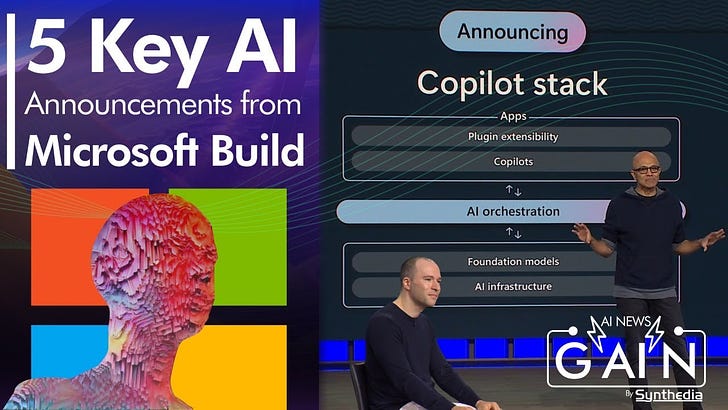Microsoft Announcements About AI Copilots, Plugins, and ChatGPT Signal a Market Shift
The rise of enterprise AI copilots, OpenAI, and Microsoft's agenda
Microsoft is setting the consumer and corporate generative AI agenda right now. Today the company once again demonstrated that it is well ahead of its peers in the completeness of its vision and readiness of its solutions.
Much of that lead is attributed to its long-time collaboration with and plurality financial ownership position in OpenAI. However, Microsoft’s annual Build developer conference announcements also signal a shift. OpenAI may be the technology leader in the relationship, but Microsoft is the business leader driving a comprehensive strategy and formidable product portfolio.
Click the video above to hear Eric Schwartz and my rundown of the five most significant announcements from Build. We go into some depth on several of the topics. While you are on YouTube, please give the video a like. I’d appreciate it.
Below, I have compiled several key takeaways beyond what is in the video. This includes a brief assessment of the generative AI market competitive landscape.
Key Announcements from Build
Microsoft CEO Satya Nadella said over 50 announcements would be made during Build. While some of those announcements are surely unrelated to generative AI, all of Nadella’s top five were squarely in this segment. There is no doubt that Nadella sees Microsoft’s generative AI strategy as central to the company strategy.
Some of the key generative AI announcements from Build include:
Bing Search in ChatGPT - Bing will become the default ChatGPT search experience. The default ChatGPT configuration will remain unchanged. However, users will be able to select the Bing Chat model to conduct real-time internet searches which in ChatGPT. 🔍
Plugins Coming to Azure OpenAI and Bing - Developers using OpenAI GPT-3.5 and GPT-4 models through Azure OpenAI Services will be able to access several Microsoft services as plugins. Some of these include Bing Search, Azure Cognitive Search, Azure SQL, Azure Cosmos DB, and Microsoft Translator. Microsoft also said that the GPT models and Bing would all have access to the plugins for ChatGPT and vice versa. There is one common plugin model. 🔌
Windows Copilot - Windows will include a chat-based copilot. “Windows Copilot provides personalized answers and helps users take action within Windows 11, like changing a setting, playing a specific playlist, or opening a relevant app. Windows Copilot brings Bing Chat, the knowledge of the web, and can even include the current context across a user’s applications to help them get even more relevant answers.” It looks like a pretty useful desktop helper that is more advanced than Clippy. 📎
GitHub Copilot Chat - A ChatGPT-like chatbot for VS Code and Visual Studio. According to Microsoft: “We are bringing a chat interface to the editor that's focused on developer scenarios and natively integrates with VS Code and Visual Studio. This does far more than suggest code. GitHub Copilot chat is not just a chat window. It understands what code a developer has typed, what error messages are shown, and it's deeply integrated into the IDE. A developer can get in-depth analysis and explanations of what code blocks are intended to do, generate unit tests, and even get proposed fixes to bugs.” Signup for the waitlist here.
Build Your Own ChatGPT-like Copilot with Azure AI Studio - This is central to the big shift to the enterprise for generative AI. Microsoft wants everyone to build their own copilots, and one key element of that is to point the GPT AI models to the enterprise’s data. 🤖
Copilot Stack architecture - Over 4,500 companies are now using Azure OpenAI services to get access to OpenAI’s GPT models. Microsoft wants to enable these companies to build copilots for any important task. “While Microsoft has deployed generative AI technology into the company’s products and services, developers will eventually build most of the copilots in the world,” according to Kevin Scott, Microsoft’s CTO. In addition to Azure AI Studio, Microsoft is also providing a new AI orchestration solution and enables connections to third-party orchestration such as LangChain. While today, you have to stitch together various services to create generative AI solutions, Microsoft is trying to make this far easier by integrating all of the necessary components. ⚙️
Mircosoft Fabric for Analytics - Microsoft recognizes that all of these generative AI solutions and conversational interactions will create even more data. Microsoft Fabric is the company’s new model for integrating enterprise data sources with analytics tools and a copilot for data analytics. Beyond the data query chatbot, a key benefit is portability across the infrastructure. The company says, “Fabric is a unified platform for analytics that includes data engineering, data integration, data warehousing, data science, real-time analytics, applied observability and business intelligence, all connected to a single data repository called OneLake…With Copilot in Microsoft Fabric in every data experience, customers can use conversational language to create dataflows and data pipelines, generate code and entire functions, build machine learning models or visualize results. Customers can even create their own conversational language experiences that combine Azure OpenAI Service models and their data and publish them as plugins.” Sounds interesting. 🧐
Will Microsoft Win?
Many more new features inside of the Copilot stack and across other services received attention today at the Build conference. This may have looked like just another company developer conference, and it is possible little will come of it. However, a few points are worth noting.
We know that Microsoft has high-quality components from OpenAI, Azure, and business productivity.
We know that Microsoft has a very large installed user base.
We saw today a logical and comprehensive set of integrated solutions that will make it easy to build robust, customized solutions.
It may turn out that it is simply easier to prototype or build highly capable generative AI solutions on Azure because everything is in one place, and the architectures are already thought through. This offers a de facto standard for both Microsoft and third-party services.
And a big question for any enterprise deciding how to proceed with generative AI is who they feel comfortable trusting. They might not be that comfortable with OpenAI or the many capable startups out there. However, most of them trust Microsoft. If it’s easier to build and you already trust the provider, that may be the path of least resistance.







